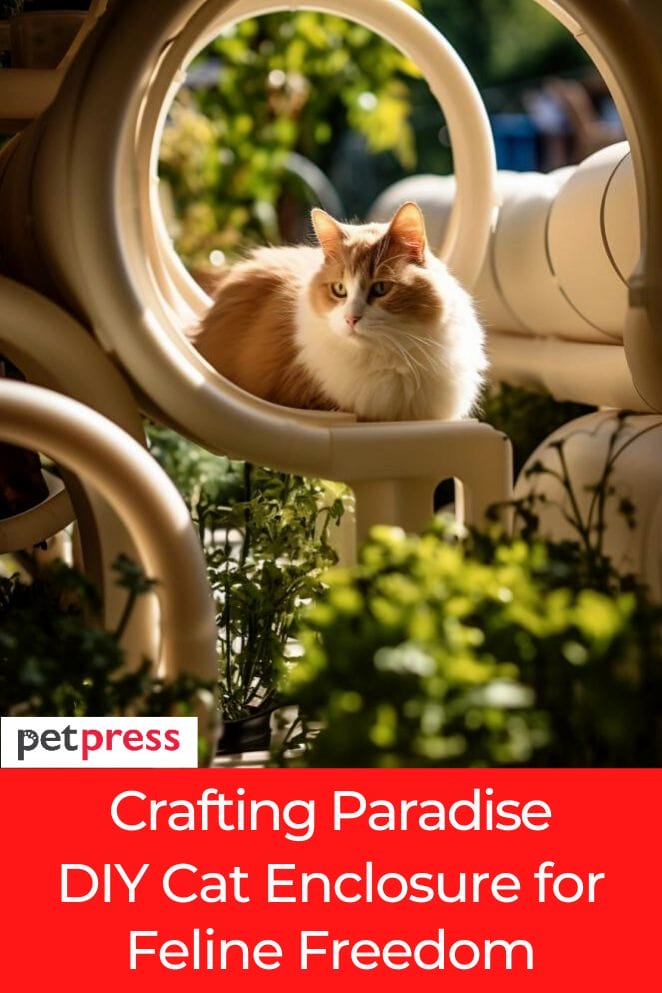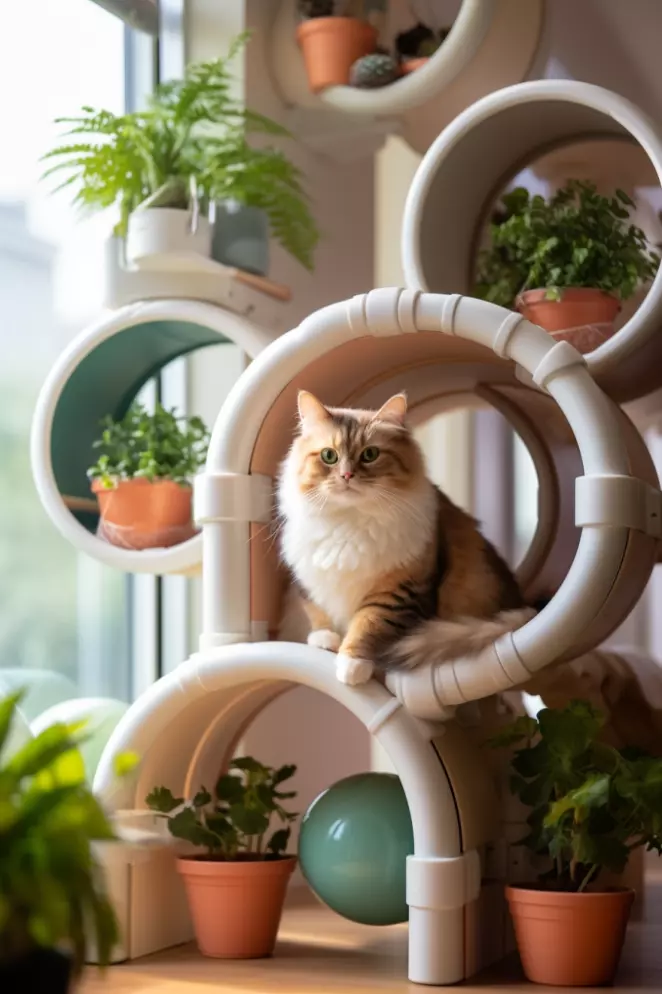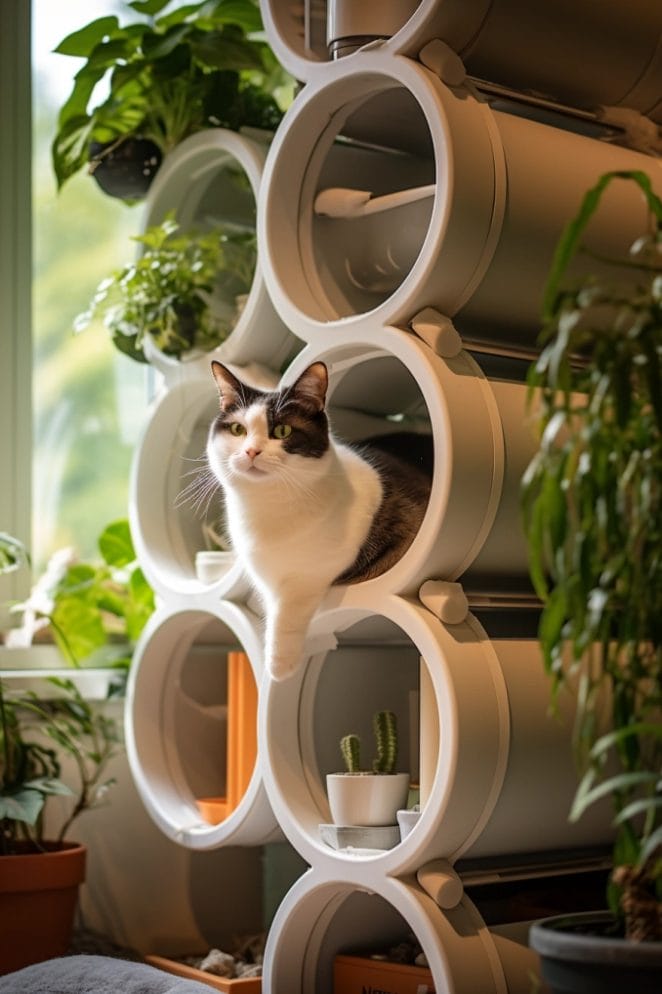
Greetings, cat enthusiasts!
If you’ve envisioned offering your beloved feline a slice of outdoor bliss without compromising their safety, a DIY cat enclosure could be the ideal solution.
This all-encompassing guide will delve into the advantages of crafting your cat haven and provide a step-by-step walkthrough for planning, designing, and constructing a cat enclosure that will be a source of delight for your furry companion.
Benefits of a DIY Cat Enclosure
Before we dive into the nitty-gritty, let’s explore why a DIY cat enclosure is a fantastic idea:
- Safety: Keep your cat protected from outdoor dangers like traffic, predators, and other hazards.
- Enrichment: Provide an environment for climbing, exploring, and lounging, satisfying your cat’s natural instincts.
- Customization: Tailor the enclosure to your cat’s preferences, incorporating elements that cater to their unique needs.
- Health benefits: Outdoor exposure can enhance your cat’s overall well-being, from mental stimulation to physical exercise.
How to Build a DIY Cat Enclosure

- Related post: DIY Cat Bridge: Construct a Feline Highway for Your Home
- Related post: DIY Cat Cave: Create a Cozy Retreat for Your Feline Friend
Planning Your DIY Cat Enclosure
Assessing space
Evaluate available area
- Begin by assessing the available space for your feline retreat. Consider both the size and location to ensure it’s suitable for your cat’s needs.
- Think vertically to maximize space utilization, providing climbing structures that cater to your cat’s natural instincts.
Create functional zones
- Designate areas for climbing structures, ensuring various heights and platforms for exploration.
- Incorporate hiding spots for moments of privacy and relaxation.
- Integrate sunny spots for basking, considering your cat’s love for warmth.
Choosing materials
Select cat-friendly materials
- Opt for cat-friendly materials that guarantee both safety and enjoyment.
- Consider using PVC pipes for sturdy structures, wire mesh for secure enclosures, and outdoor fabric for comfortable lounging spots.
- Ensure that materials are durable and able to withstand outdoor conditions.
Prioritize safety
- Avoid materials that may be toxic to cats. Ensure that all chosen materials prioritize your cat’s safety.
- Double-check the durability of the materials, especially if your DIY enclosure will be exposed to various weather conditions.
Designing the Enclosure
Sketching the layout
Blueprint your vision
- Begin the design process by sketching a blueprint that serves as a visual guide for construction.
- Plan the layout with climbing structures, strategically placed resting areas, and elevated perches to cater to your cat’s natural behaviors.
- Embrace vertical space, acknowledging your cat’s innate love for heights and vantage points.
Incorporating platforms and shelves
Enhance the feline experience
- Elevate your cat’s outdoor haven by incorporating multiple levels within the enclosure.
- Integrate platforms, shelves, and designated resting spots to provide a variety of engaging spaces.
- Design various levels that cater to climbing, lounging, and observing, allowing your cat to fully explore and enjoy their surroundings.
Cater to climbing instincts
- Consider placing platforms at different heights, and encouraging climbing activities that mimic the natural behavior of cats.
- Ensure the platforms are stable and securely anchored to provide a safe and enjoyable climbing experience.

Assembling the frame
Cutting and Connecting PVC Pipes
Crafting a sturdy frame
- Begin the construction process by cutting PVC pipes to your desired lengths, considering the layout outlined in your sketch.
- Connect the PVC pipes using secure connectors, ensuring a stable and robust foundation for the entire enclosure.
- Double-check the connections to guarantee the structural integrity of the frame.
Attaching wire mesh
Securing the cat’s environment
- Enhance the safety of the enclosure by attaching durable wire mesh to the PVC frame.
- Leave no gaps in the mesh to prevent potential escapes, ensuring a secure environment for your cat.
- Choose a cat-safe mesh that can withstand your cat’s curiosity and playfulness.
Selecting the right mesh
- Opt for a mesh with small openings to prevent your cat from squeezing through.
- Ensure the mesh material is sturdy and durable, capable of withstanding outdoor conditions.
- Regularly inspect and maintain the mesh to address any wear or damage.
Adding roof and sun protection
Prioritizing Cat Comfort
- Ensure your cat’s well-being in all weather conditions by providing a protective roof over the enclosure.
- Integrate outdoor fabric or shade cloth to offer essential sun protection, allowing your cat to enjoy the outdoors comfortably.
Creating safe entrances and exits

Ensuring secure access
- Guarantee secure access for your cat by incorporating zipper openings or flap doors as entrances and exits.
- Utilize reliable closures to prevent any accidental escapes, ensuring your cat remains safely within the enclosure.
Adding Enrichment
Transforming into a feline playground
Elevate the enclosure into a stimulating feline playground by integrating cat-friendly elements.
Add catnip or hanging toys to keep your cat engaged and entertained within their outdoor haven.
Incorporating stimulating elements
- Integrate cat-friendly plants for sensory enrichment, providing your cat with new scents and textures.
- Place toys strategically to encourage play and exploration.
- Create hiding spots using structures or plants to fulfill your cat’s natural instincts.
Tips for Building a DIY Cat Enclosure

Crafting a DIY cat enclosure can be a rewarding project, providing your feline companion with a safe and stimulating space.
Here are key tips to ensure your construction is a purr-fect success:
Precision matters
Take the time to measure twice before making any cuts.
Accurate measurements lay the foundation for a sturdy and well-proportioned enclosure.
This extra effort upfront can save you from potential construction headaches later on.
Secure all connectors
When working with PVC connectors, prioritize a secure fit.
Tighten them properly to ensure stability and prevent any wobbling or sagging.
A securely connected framework is vital for the overall strength and durability of the enclosure.
Regular maintenance
Like any well-loved space, your DIY cat enclosure requires regular upkeep.
Schedule routine inspections to identify and address any wear and tear.
This could involve checking for loose connectors, examining the condition of climbing surfaces, and cleaning any resting areas.
Observe your cat
Your cat’s happiness is the ultimate goal, so pay close attention to their behavior within the enclosure.
Observe their favorite spots, scratching preferences, and any signs of discomfort.
Make adjustments accordingly – it could be adding an extra perch, incorporating a cozy hiding spot, or introducing new textures for scratching.
- Related post: How to Build a Catio: A Guide for the Purr-fect DIY Project
- Related post: 10 DIY Cat Shelves That Look Purr-fectly Fabulous
Conclusion
By successfully creating a DIY cat enclosure, you’ve provided your feline companion with a personalized haven that combines safety, enrichment, and joy.
This carefully crafted space is a testament to your dedication to their well-being.
As your cat explores, plays, and relaxes in this outdoor paradise, the bond between you and your furry friend is strengthened.
Congratulations on this achievement, and may the shared experiences within this haven bring continual joy to both you and your cherished cat.


GIPHY App Key not set. Please check settings